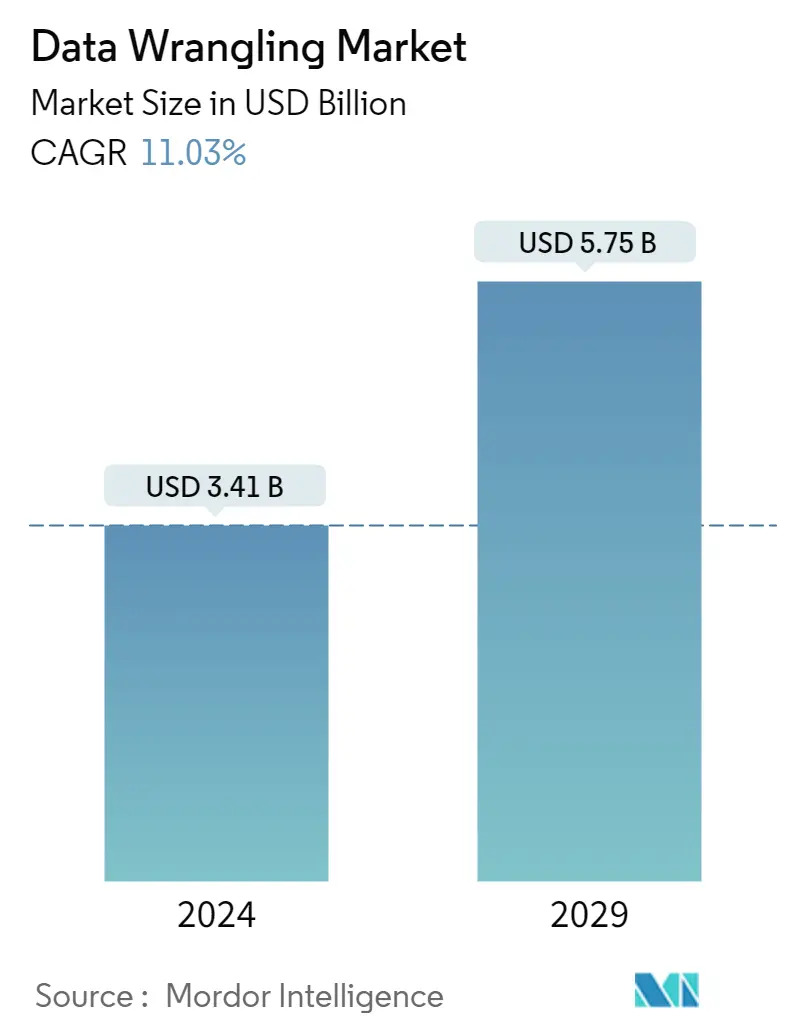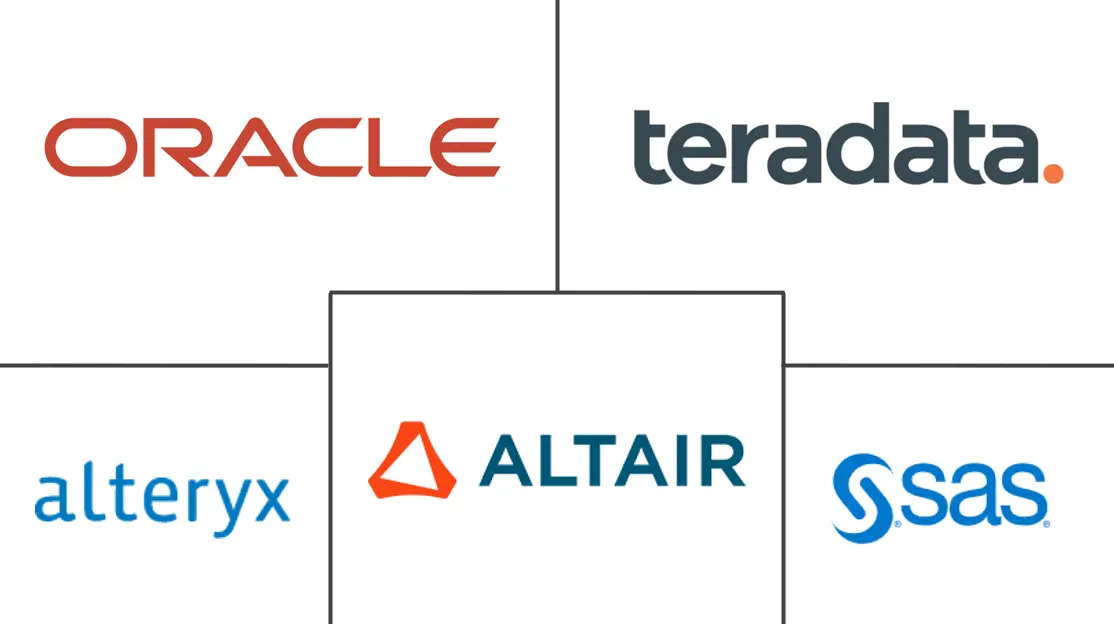Market Size of Data Wrangling Industry

| Study Period | 2019 - 2029 |
| Market Size (2024) | USD 3.41 Billion |
| Market Size (2029) | USD 5.75 Billion |
| CAGR (2024 - 2029) | 11.03 % |
| Fastest Growing Market | Asia-Pacific |
| Largest Market | North America |
| Market Concentration | High |
Major Players
*Disclaimer: Major Players sorted in no particular order |
Data Wrangling Market Analysis
The Data Wrangling Market size is estimated at USD 3.41 billion in 2024, and is expected to reach USD 5.75 billion by 2029, growing at a CAGR of 11.03% during the forecast period (2024-2029).
The creation of various automated technologies has already enhanced and improved the data-wrangling procedure. The industry would create more complex AI solutions during the forecast period to assist the processes of data wrangling and data analysis.
- The adoption of sophisticated analytics algorithms to choose insights that might revolutionize a business entity results from the rapid development in the quantity and reliability of data collected throughout many industrial verticals. Massive amounts of unstructured data have also been produced due to the surge in Big Data usage. Applications for iterative and interactive data wrangling may identify distributions and inconsistencies and suggest process improvement.
- Data manipulation can offer statistical insights into the metadata by making the information more consistent. Increased metadata consistency makes it possible for automated technologies to examine the data more quickly and precisely, frequently leading to these findings. Data wrangling would clean the information to enable a model to operate without problems, mainly in developing a model about expected market performance.
- Businesses are increasingly using data wrangling for real-time forecasting and monitoring of numerous events that may impact their performance. The market for data wrangling is expanding due to the potential to mitigate risks by executing complicated judgments concerning unplanned occurrences, such as cyberattacks and other emergencies. Also, as more cyberattacks occur, there is a growing demand for data wrangling since it makes data simpler to find and recover.
- Growing concerns about information loss and theft, expanding Bring Your Own Device (BYOD) trends, and business mobility are just a few factors that are significantly accelerating the growth of the data wrangling market.The industry of data wrangling is predicted to benefit significantly from advances in edge computing.
- However, issues with data quality are limiting the market's ability to expand.The data-wrangling industry is anticipated to face challenges due to a lack of readiness to switch from conventional ETL tools to cutting-edge automated technologies. Further, one of the key obstacles to this market's expansion is the lack of knowledge about data-wrangling tools among small and medium-sized businesses.
- The COVID-19 epidemic brought on a considerable data influx. Technological firms and data aggregators exploited local data from cell towers and mobile applications to impose social segregation and close the gaps using dashboards that monitored and tracked contacts. Applications predicted hospital requirements and epidemic burden using Bluetooth, modeling efforts, and geolocation services. As a result of the flawed data produced throughout this procedure, millions of people were expected to be negatively impacted. Data wrangling is used to clean, arrange, and enhance raw data into the appropriate format for users to make better decisions more quickly and accurately. As a result, COVID-19's requirement for data wrangling provided market potential for expansion.
Data Wrangling Industry Segmentation
Data wrangling is defined as the process of preparing raw data for analysis by cleaning, arranging, and converting it into the required format. Data wrangling, also known as data cleaning or data munging, helps organizations handle more complicated data in less time, create more accurate results, and make better decisions.
The data wrangling market is segmented by component (tool, service), deployment (cloud-based, on-premises), enterprise type (large, small, and medium-sized), end-user industry (IT and telecommunication, retail, government, BFSI, and healthcare), and geography (North America, Europe, Asia-Pacific, Latin America, and the Middle East and Africa).
The market sizes and forecasts are provided in terms of value (USD) for all the above segments.
| By Component | |
| Tools | |
| Service |
| By Deployment | |
| Cloud-Based | |
| On-premises |
| By Enterprise Type | |
| Small and Medium Sized | |
| Large |
| By End-user Industry | |
| IT and Telecommunication | |
| Retail | |
| Government | |
| BFSI | |
| Healthcare | |
| Other End-user Industries |
| Geography | ||||||
| ||||||
| ||||||
| ||||||
| ||||||
|
Data Wrangling Market Size Summary
The data wrangling market is poised for significant growth, driven by the increasing complexity of data management needs across various industries. As businesses generate and collect vast amounts of unstructured data, the demand for sophisticated analytics and automated data wrangling solutions is on the rise. These technologies are essential for cleaning, organizing, and enhancing data to enable accurate and timely decision-making. The market is expected to expand as organizations seek to leverage data for real-time forecasting, risk mitigation, and performance monitoring. The proliferation of big data, coupled with the need for robust cybersecurity measures, further fuels the demand for data wrangling solutions. However, challenges such as data quality issues and the transition from traditional ETL tools to advanced automated technologies may hinder market growth, particularly among small and medium-sized enterprises.
North America is anticipated to lead the data wrangling market, supported by the presence of major vendors and the region's proactive adoption of Industry 4.0 services. The region's companies benefit from the ability to collect and analyze large volumes of data, driving the demand for data wrangling tools and services. Key players in the market, such as Alteryx, Oracle, and Teradata, continue to innovate and expand their offerings through strategic partnerships and acquisitions, solidifying their market positions. The post-pandemic surge in cloud adoption further accelerates market growth in North America. As large enterprises increasingly recognize the importance of data wrangling for managing big data challenges, the market is expected to see substantial expansion, with significant opportunities arising from advancements in edge computing and AI integration.
Data Wrangling Market Size - Table of Contents
-
1. MARKET INSIGHTS
-
1.1 Market Overview
-
1.2 Industry Value Chain Analysis
-
1.3 Industry Attractiveness - Porter's Five Forces Analysis
-
1.3.1 Bargaining Power of Suppliers
-
1.3.2 Bargaining Power of Buyers/Consumers
-
1.3.3 Threat of New Entrants
-
1.3.4 Threat of Substitute Products
-
1.3.5 Intensity of Competitive Rivalry
-
-
1.4 Assessment of the Impact of COVID-19 on the Market
-
-
2. MARKET SEGMENTATION
-
2.1 By Component
-
2.1.1 Tools
-
2.1.2 Service
-
-
2.2 By Deployment
-
2.2.1 Cloud-Based
-
2.2.2 On-premises
-
-
2.3 By Enterprise Type
-
2.3.1 Small and Medium Sized
-
2.3.2 Large
-
-
2.4 By End-user Industry
-
2.4.1 IT and Telecommunication
-
2.4.2 Retail
-
2.4.3 Government
-
2.4.4 BFSI
-
2.4.5 Healthcare
-
2.4.6 Other End-user Industries
-
-
2.5 Geography
-
2.5.1 North America
-
2.5.1.1 United States
-
2.5.1.2 Canada
-
-
2.5.2 Europe
-
2.5.2.1 United Kingdom
-
2.5.2.2 Germany
-
2.5.2.3 France
-
2.5.2.4 Rest of Europe
-
-
2.5.3 Asia-Pacific
-
2.5.3.1 China
-
2.5.3.2 Japan
-
2.5.3.3 Singapore
-
2.5.3.4 Rest of Asia-Pacific
-
-
2.5.4 Latin America
-
2.5.4.1 Mexico
-
2.5.4.2 Brazil
-
2.5.4.3 Rest of Latin America
-
-
2.5.5 Middle East and Africa
-
2.5.5.1 United Arab Emirates
-
2.5.5.2 Saudi Arabia
-
2.5.5.3 Rest of Middle-East & Africa
-
-
-
Data Wrangling Market Size FAQs
How big is the Data Wrangling Market?
The Data Wrangling Market size is expected to reach USD 3.41 billion in 2024 and grow at a CAGR of 11.03% to reach USD 5.75 billion by 2029.
What is the current Data Wrangling Market size?
In 2024, the Data Wrangling Market size is expected to reach USD 3.41 billion.

